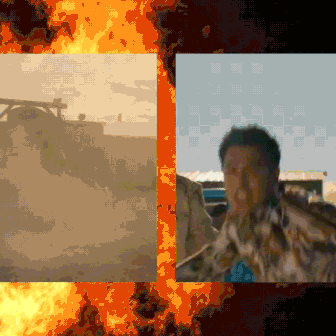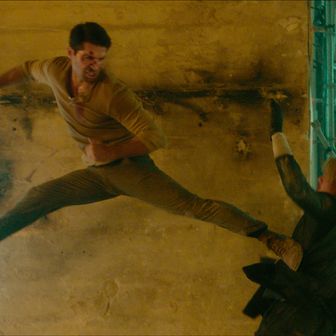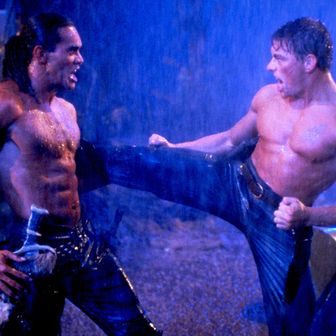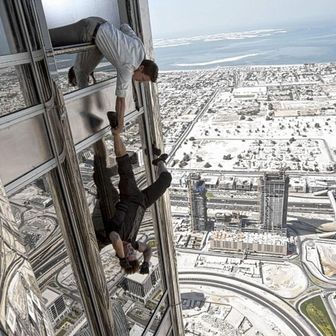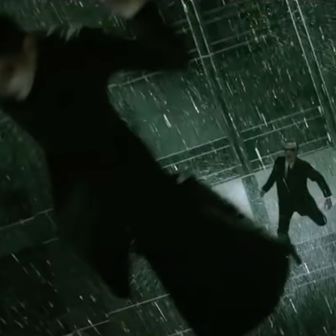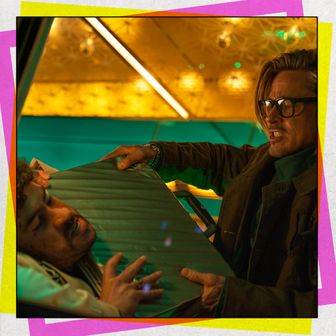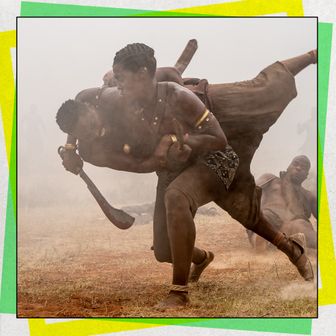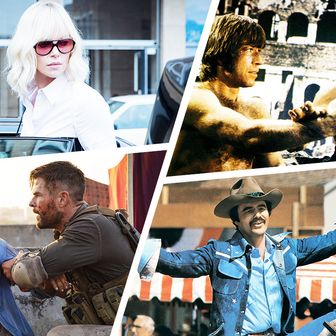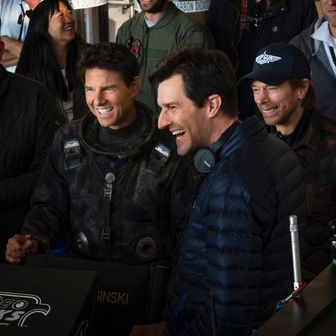
There’s no storyteller quite like a stuntperson. Their work is all about action and character — every time they take a jaw-dropping car hit, throw themselves off a roof with no parachute, or set themselves on fire, it’s all to enhance whatever story is being told. And when it comes to creating spectacle, stuntpeople are a crucial part of setting the parameters of a reality, whether they are flying in the air thanks to wire fu, or making a punch look extra painful in an indie movie’s bar fight. From the beginning of the moving image, stuntpeople have been showing us what is possible in whatever world is being captured on camera.
Some of the best action movies — and some of the best movies, period — are directed by stuntpeople. But that shouldn’t be surprising, as by their trade they become connected to the stakes of any project. When stuntpeople are in front of the camera, they do the dangerous work that bankable stars can’t do for numerous financial reasons. And, when stuntpeople work behind the camera as coordinators, or level up to second unit as so many have, they do the work a lot of first-unit directors pass off because of a lack of action experience but will still get the credit for. The best stuntpeople-turned-directors recognize how there is no such rigid definition to action. As John Wick: Chapter 4 director Chad Stahelski tells martial-arts star Scott Adkins on the latter’s indispensable Art of Action YouTube series, “Action is blocking, action is filming, action is editing, action is angles, action is storytelling. It’s no different than doing a scene talking.”
The films of stuntpeople-turned-directors are an expression of the hits, falls, and painful kicks to the face you wouldn’t want to experience in real life. But thanks to their wisdom and their commitment to a film set’s safety, you can — from the comfort of a theater or your couch. Below is a look at how 18 stuntpeople turned their expertise into must-see films.
Buster Keaton, The General (1926)
This list celebrates almost a century of stuntpeople-turned-directors and their incredible cinematic feats, but perhaps nobody did it better than one of the first to ever do it. Silent star Buster Keaton’s The General (co-directed with Clyde Bruckman) is an unparalleled bit of stunt-driven filmmaking, in part because Hollywood has certainly become more safety-focused than it was in the mid-1920s when Keaton was crashing a locomotive train, destroying a bridge, and playing all this danger and destruction for both action and comedy, equally. The set-up is simple — Keaton’s Johnnie Gray tries to retrieve the locomotive during the Civil War from Union spies. But the journey is packed with jaw-dropping stunts, with Keaton’s underdog sometimes hanging off the front of the moving train, scampering to avoid a derailment or grave injury. Although the movie was a box-office failure when it debuted (the New York Times called it “a mixture of cast iron and jelly”), history vindicated The General. It entertains eternally, having laid the groundwork for the first action hero and then showing how much fun it is to blow up the tracks with cameras rolling.
Bruce Lee, The Way of the Dragon (1972)
Bruce Lee has had an indelible influence on martial arts in movies — and therefore all of stuntwork — but we tragically only have one directorial feature to understand how he thought cinematically. Still, his 1972 box-office success The Way of the Dragon is a superlative movie of its kind because of Lee’s dedication behind the camera, including a final battle in the Coliseum opposite Chuck Norris that he reportedly spent 45 hours filming. Other scenes show his precision as a martial artist, like how he carefully fires out his nunchucks when knocking down thugs in another noteworthy sequence. His choreography as fish-out-of-water Tang holding his own creates a gripping spectacle all its own. When he’s cornered, we’re never sure how he’ll strike next, but always aware he is a few steps ahead of his opponent. Lee’s directing shares much of the same methodical nature, and it can be exhilarating to witness this legend unleash that savviness with little compromise.
Hal Needham, Hooper (1978)
Some stunt-driven projects have an exhilarating “let’s put on a show” air to them, in which impossible and dangerous feats are treated like circus acts, performed with a smile. The legendary stuntman-turned-director Hal Needham — who doubled for Charles Bronson, Dean Martin, and Kirk Douglas and later founded the Stunts Unlimited organization — celebrated this ethos with Hooper. The 1978 film, starring the winking surrogate of his cinema, Burt Reynolds (who also got his start as a stuntman), was the duo’s follow-up to Smokey and the Bandit, a huge hit filled with car chases and reckless driving. Hooper is even more of a hangout movie and even more dazzling. The film, in a somewhat meta sense, depicts casual travails of being a stuntman in Hollywood, giving Reynolds and company a perfect excuse to perform the wildest tricks: Reynolds’s stunt double, A.J. Bakunas, performed a 230-foot fall from a helicopter without a parachute for a gag; a pickup truck drives backward on the highway in unison with other cars. The grand finale is a record-breaking 325-foot car launch across a broken bridge, executed by Buddy Joe Hooker, a prolific stunt driver who later doubled Kurt Russell in Quentin Tarantino’s Death Proof. The stunt is so dangerous and ridiculous that it leads up with a rollicking sequence of Reynolds and other stuntmen blitzing through an exploding, collapsing World War II military hospital (it’s a climax for the movie-within-a-movie that Reynolds’s character is making). Hooper is so fun because it can be so over the top. There aren’t any computer effects to get in the way — it’s just chaotic but controlled derring-do.
Buddy Van Horn, Any Which Way You Can (1980)
When Clint Eastwood needed a director to help follow up the major box-office success of his scrappy 1978 comedy Every Which Way But Loose — in which he co-starred with an orangutan named Clyde — he enlisted someone he had worked with closely over the past few years, stuntman Buddy Van Horn. Van Horn helped create Eastwood’s onscreen brawn by doubling for him in many films (like when he clung to the hood of a speeding car in the Dirty Harry sequel Magnum Force) while also acting as stunt coordinator for those projects. (When Van Horn died in 2011, Eastwood told Variety in a statement, “Buddy has saved my life throughout the years … he took all my hits.”) For his directorial debut, Van Horn gave Any Which Way You Can the easygoing adrenaline it needs, packing it with ensemble slapstick, bare-knuckle boxing, and yeehaw truck-driving stunts. The wacky film was a box-office success, and Van Horn’s playful, subversive use of the action star affirmed that whenever Eastwood didn’t want to be Dirty Harry, he had a future ahead of him in a comedy.
Jackie Chan, Police Story (1985)
Jackie Chan’s directorial career is full of many gems, but it’s best summed up with the work that he has also cited as his favorite: Police Story. Co-written by and starring Chan, Police Story is an example of a stuntperson directing so that there are fewer people who can tell them “No, don’t do that!” The result is a maximum spectacle that thrills from start to finish and often looks plenty painful. Chan takes full advantage of his settings and multiplies what makes them dangerous, as in a bravura, high-speed fight scene in a mall that co-stars a whole lot of broken glass, or a downhill car-chase scene that has Chan and company barreling through wooden shacks. Charismatic as ever in his everyman persona, Chan pushes himself in Police Story to take dangerous leaps, as he does in a finale when he slides down a metal pole in the mall (and shocks himself in the process). Chan also sings the earworm song that plays over his end credits, which are accompanied by outtakes — something he picked up from Hal Needham after appearing in Cannonball Run II — that detail behind-the-scenes of the bone-crunching stunts that went into Chan’s nonpareil piece of entertainment.
Craig R. Baxley, Action Jackson (1988)
The nickname of “Action” isn’t handed out to just any movie character, and with the original screenplay Action Jackson director Craig R. Baxley had to prove what kind of extreme life choices would earn someone that title. The former stunt man, driver, and coordinator (on shows like The Dukes of Hazzard and The A-Team) rose to the challenge by surrounding its title hero (played by Carl Weathers) with a wealth of breathtaking feats, like when Weathers clings to a taxi blitzing through downtown Detroit, or later when Action Jackson drives a sports car up the staircase and through the decadent hallways of a gaudy mansion. Weathers is more than just a trope-built ’80s hero (although he has the cheesy lines) because of Baxley’s imagination and sensibilities, which are jaw-dropping — like when Action Jackson tosses one bad guy out of a window, over an alleyway, and through another window. Thanks to Baxley and his crew (including MVP stunt coordinator Jophery Brown, who worked on Lethal Weapon, Die Hard, Predator, and more), Action Jackson delivers on its name and then some.
Sammo Hung, Dragons Forever (1988)
Sammo Hung and Jackie Chan are one of the greatest stunt duos of all time. Hung, known as “Big Brother” from his days of teaching Chan and other future martial-arts fixtures at the Peking Opera, worked his way from this school to become a stuntman and coordinator in his own right. He later started directing his own star vehicles, which made him a beloved star in Hong Kong cinema. Hung and Chan have a long list of collaborations, and arguably their greatest is the action-comedy Dragons Forever, co-directed with Cory Yuen. Starring Hung, Chan, and their Peking Opera “brother” Yuen Biao, the film flourishes from its fast action and tight filmmaking, balanced with a sense of action-comedy that has Chan and Hung sometimes bickering and ending up with black eyes. The fight scenes featuring Hung and Chan, spread throughout the movie, are dazzling and fast-paced, in part because of how they are filmed with exquisite clarity and how they’re given even more dynamic by Hung’s trademark sense of comedic rhythm.
Yuen Woo Ping, Iron Monkey (1993)
Hollywood audiences who saw The Matrix and Crouching Tiger, Hidden Dragon at the start of the new millennium got an exhilarating taste of the kung fu artistry of Yuen Woo Ping and his gravity-defying spectacle. Such mastery is the product of Yuen’s prolific work in Hong Kong cinema, starting with his days as a stuntman for Shaw Brothers productions, and then eventually moving from stunt coordinator to revered kung fu feature director. One of his most beloved directorial feats, 1993’s Iron Monkey, has him working with Donnie Yen and embracing the high-flying, stylized way of martial arts that has him sending heroes and villains soaring through the air. It’s a work of spectacular physical imagination, one in which the choreography writes and rewrites the laws of physics while telling a story of a Robin Hood figure that Yen’s character must hunt. The movie is a dazzling feat of Yuen’s cinematic style, which fully embraces the possibility of a prop (Yen fighting with an umbrella) or an unpredictable setting for a fight, as in the bravura climax that has its remaining fighters leaping and balancing on thin poles above a blazing fire.
Donnie Yen, Legend of the Wolf (1997)
While building his own martial-arts stardom, Donnie Yen finally got behind the camera for 1997’s The Legend of the Wolf, also known as The Big New Boss. Yen’s way of filming himself at his brawling best is wildly dynamic, with quick cuts during fight scenes that match the flurry of punches he unleashes on one unlucky target’s chest. While the picture’s plotting is a little slack, Yen has a great sense of how to present his limber choreography, complemented by a bold use of shadows, low angles, and color filters. By moving the camera ever so slightly during his many ensemble takedown scenes, he guides one’s eye from one hit to the next. Legend of the Wolf is that rare piece of action filmmaking that shows how quick scenes can be just as comprehensible as those that are slower, and Yen gives this thrilling directorial debut his all.
David R. Ellis, Final Destination 2 (2003)
Stunt performers have a tendency to go into action filmmaking when they move behind the camera, but Final Destination 2, perhaps the best entry in the horror franchise, shows how readily a stuntperson’s talents lend themselves to other genres. David R. Ellis, who worked as a stuntman (often for Hal Needham) and later was second unit director for massive movies like Waterworld, The Matrix Reloaded, and the Quidditch scene in Harry Potter and the Sorcerer’s Stone, brought his expertise and values to the disaster series, highlighting how great coordinated stunt work can be used to make things look extra painful. The movie is full of controlled chaos that minimizes the use of CGI, and its opening scene — hands down the best in the series — is a particular gem: A cop car is impaled by a tree trunk; a ditched motorcycle slides and crushes its pinned owner; cars explode into balls of fire when they collide. As a whole, the movie flourishes with Ellis’s eye for practical chaos, reminding us how stunts can be so persuasive when they look painful or even deadly, but the best coordinators ensure equal safety and ingenuity for their cast and crew. Ellis, unfortunately, died at the age of 60 in 2013, but his career is a great example of the versatility of stunt work as an art form.
Tony Jaa, Ong Bak 2 (2008)
After gaining an international following with his Muay Thai fights in 2003’s Ong Bak and 2005’s The Protector, Thai superstar Tony Jaa followed the path of other martial-arts greats by getting behind the camera to work as a director for Ong Bak 2. (Panna Rittikrai has a co-director credit, having helped Jaa finish the film). A prequel that goes 500 years back from the first movie, Ong Bak 2 has Jaa putting it all on the screen, mixing in various martial arts styles that he loves: Thai boxing, sword fighting, baton fighting, drunken boxing, kung fu, and more. And as a performer who does many of his own stunts, he puts so much on the line here to create a jaw-dropping spectacle, like in a dangerous scene in which he hops between moving elephants. With Jaa casting himself as a martial-arts hero, the film yields numerous exceptional, visceral fight scenes where his elbows and knees are weaponized, as filmed with wide shots and long takes that help ensure the hits reach full dramatic impact. Jaa is also credited as action choreographer, and his dedication to such ferocious storytelling makes Ong Bak 2 one the most brutal martial-arts films of the 21st century.
Diana Lee Inosanto, The Sensei (2008)
The list of talented stuntwomen in Hollywood is ever-expanding (April Wright’s must-see 2020 documentary, Stuntwomen: The Untold Story, highlights several of them). But the roster of stuntwomen-turned-directors is just getting started, featuring the likes of Zoë Bell of Death Proof (currently working on her own action comedy) and the writer-director of The Sensei, Diana Lee Inosanto. Inosanto is the goddaughter of Bruce Lee, the daughter of martial-arts authority Dan Inosanto, and has acted as a stuntwoman for movies like Face/Off, Hulk, Alita: Battle Angel, and had pivotal fight scenes as Morgan Elsbeth in season two of The Mandalorian. For her directorial debut, she funneled her passion for martial arts into this Karate Kid–inspired story, in which she stars as a black-belt instructor who teaches a bullied gay high-school boy (Michael O’Laskey II’s McClain) the way of self-defense. Inosanto’s drama works on multiple levels, including the power that comes from her own fight scenes when she takes on a few of McClain’s bullies. The Sensei boasts the type of clear, effective filmmaking that empowers a character in the audience’s eyes, and could only be accomplished by someone of Insanto’s caliber. It’s equally thrilling to see that Inosanto is a member of the Alliance of Women Directors and that she is currently in development on several projects.
Scott Waugh, Need for Speed (2014)
Fast and furious speeds are so often only imitated in action movies, with stunt cars traveling anywhere between 30 and 60 mph. The camera, meanwhile, is either looking up at the Hollywood actor who is “driving” or watching the car “speed” from afar on the outside. Former stuntman Scott Waugh, who has credits in Last Action Hero, Speed, and Spider-Man, predated some of the cockpit thrills of 2022’s Top Gun: Maverick by letting viewers experience what it looks like behind the steering wheel of a car going over 200 miles per hour in 2014’s Need for Speed. In this underappreciated actioner starring Aaron Paul and based on the driving video-game franchise, Waugh’s team of precision drivers make the illegal and dangerous possible, including a 170-foot leap over a Detroit freeway (thanks to stunt double Troy Gilbert) and a blitzing race through oncoming traffic. Eschewing CG as much as possible for practical spectacle, the visuals are as in-your-face as the car movies it descends from — Bullitt, Vanishing Point — with the same controlled danger: Sports cars drift in heavy traffic; sometimes they’re smashed at high speeds and tumble through the air. Such a visceral nature is in Waugh’s DNA, as his stuntman father, Fred Waugh, invented a 35-mm. helmet camera to get viewers up close to the action. Need for Speed is a thrilling collection of chaos created by professionals, including stunt coordinator Lance Gilbert. As Waugh told the Los Angeles Times, “I take safety extremely seriously because the people doing the stunts are my friends. We’re not daredevils.”
David Leitch, Atomic Blonde (2017)
David Leitch ascended in the world of stunts by doubling the likes of Brad Pitt and Matt Damon before co-directing John Wick with his longtime stunt collaborator from design team 87eleven, Chad Stahelski. But he proved his individual directorial mettle with Atomic Blonde, a bruising actioner starring Charlize Theron based on a graphic novel of the same name. Fueled by a stunt performer’s knowledge and ambition, Atomic Blonde features a stunning ten-minute sequence made to look like one continuous shot, which has Theron’s MI6 ass-kicker brawling her way down a stairwell. It’s all the more visceral thanks to the sloppy fight choreography of Sam Hargrave (more on him later), endurance of the performers (Theron trained for months for this role, and was doubled by Monique Ganderton, who later worked as stunt coordinator and second-unit director for Loki and She-Hulk: Attorney at Law), and bruising environments. With one claustrophobic fight after the next, Leitch makes time for the audience to catch their breath while putting sneaky in-camera edits in the middle of the scuffles themselves. Best of all, this particular scene (along with other moments in the film) makes all the chest-kicking, head-hammering, and limb-snapping look properly exhausting to its characters, and, therefore, plenty cinematic.
Chad Stahelski, John Wick Chapter 3 — Parabellum (2019)
Chad Stahelski is now on his fourth John Wick movie, having started the franchise back in 2017 with uncredited co-director David Leitch, but it’s clear he has enough ideas for a dozen more. Long before John Wick became a game-changing action hero, Stahelski worked as Keanu Reeves’s stunt double in the original Matrix trilogy, while also acting as a martial-arts coordinator for The Matrix Reloaded and The Matrix Revolutions. Now he has the John Wick franchise to nurture his inspired ideas for in-your-face action. One of Stahelski’s greatest feats so far is the knife-throwing scene in John Wick Chapter 3 — Parabellum, in which Reeves’s worn-down hero must survive his attackers in a narrow hallway of glass cases with sharp objects inside. From a filmmaking standpoint it’s a marvel: Throwing knives offer a clever use of the frame’s foreground and background, recalling the playful pain of a Jackie Chan movie. But it’s the frantic yet meticulous hand-to-hand combat throughout that defines this innovative tête-à-tête, made possible by Stahelski’s savvy work with Reeves and his stunt crew. Like so much of Stahelski’s work so far, the sequence both pays homage to the greats and raises the bar for contemporary action filmmaking.
Jesse V. Johnson, Avengement (2019)
Some day — maybe after people see his fight scene with Keanu Reeves this month in John Wick: Chapter 4 — Scott Adkins will be the widely renowned martial-arts superstar he deserves to be. Until then, we have gems like his collaborations with director Jesse V. Johnson, especially their astonishingly brutal 2019 film Avengement. Johnson combines his background as a stuntman (having worked on Total Recall, Starship Troopers, The Master, and more) with his taste for character-driven fighting, and gives his star tae kwon do star Adkins a no-frills stage for his raw grandiosity. The movie is packed with tightly choreographed, wince-ready scuffles, but its last scene is a true masterwork of gnarly fight scenes, which has Adkins tearing through the men who put his character in prison and turned him into the fighting monster they now have to survive. Shot in two days, and with the sweaty filmmaking to back it up, this blood-splattering brawl caps off the movie’s overall finely choreographed spectacle.
Sam Hargrave, Extraction (2020)
Netflix actioner Extraction sneak-attacks audiences like John Wick before it: on paper, it could have made for a rote genre title, but when executed by a budding master in stunt work, it’s full of hard-hitting thrills. When the Russo brothers, who produced the film, set out to make a screenplay out of the graphic novel Ciudad, they picked their Captain America stunt double and fight coordinator (from Captain America: Civil War, Avengers: Infinity War, and Avengers: Endgame) Sam Hargrave to spike it with a visceral quality. Chris Hemsworth holds his own in the brutal action, but the real star of the movie is the physics that Hargrave and his team created for numerous stunning scenes. They take brutal falls down stairs, are launched off bikes, and at one point fall from the rooftop onto the ground below. Fitting to the movie’s “how did they shoot that?” experience, Hargrave even acted as a camera operator for one of the production’s more dangerous car stunts, putting himself feet away from being crushed during a scene of his own making. And like his coordination work on Atomic Blonde, Hargrave executes a ten-minute sequence in Extraction that incorporates claustrophobic brawls and dangerous driving after months of preparation, giving the movie a centerpiece that alone justifies the sequel coming out later this year. Speaking to CBS News about the film’s creation, Hargrave said, “It takes a lot of time to get art the way you want it. And for us, this is art. Action is art.”
J.J. Perry, Day Shift (2022)
One of the newer additions to the legacy of stuntpeople jumping into the director’s chair, J.J. Perry has been honing great action for years. After stunt work in movies like The Rundown (which won him World Stunt Award’s Male Stuntman of the Year in 2003), The Scorpion King, Iron Man, and Avatar, Perry made a name for himself as a stunt coordinator and second-unit director, taking on the latter positions for movies like The Fate of the Furious, Skyscraper, and the upcoming DC movie Blue Beetle. Perry released his first feature this year with the playful and striking horror-comedy Day Shift, starring Jamie Foxx, Dave Franco, and a batch of vampires that Perry and his team find creative ways to use. One of Perry’s most inspired flourishes involves the use of contortionists, so it looks like vampire’s backs are being turned into accordions during the movie’s hard-hitting fight scenes. And given Perry’s long background helping charge up the later Fast & Furious movies, Day Shift has its own thrilling wild chase scene that boasts stunning camerawork and excellent car choreography. As Stahelski, who produced Day Shift once said, summing up the storytelling philosophy that’s true for this movie and any other wild feature that has stuntpeople doing what only they can do: “You give ’em what they want in a way they didn’t see coming.”


